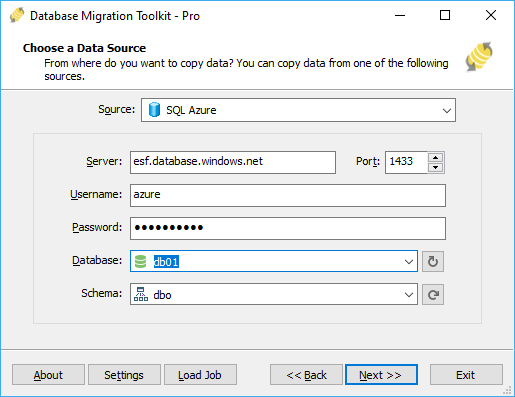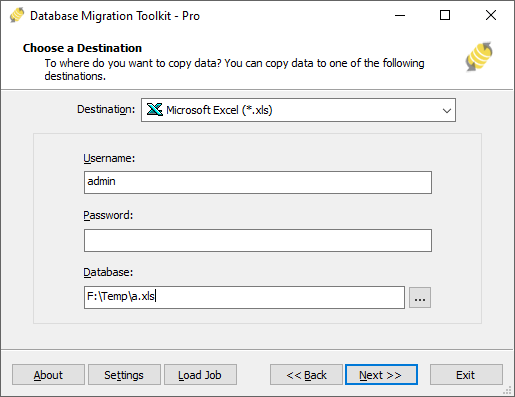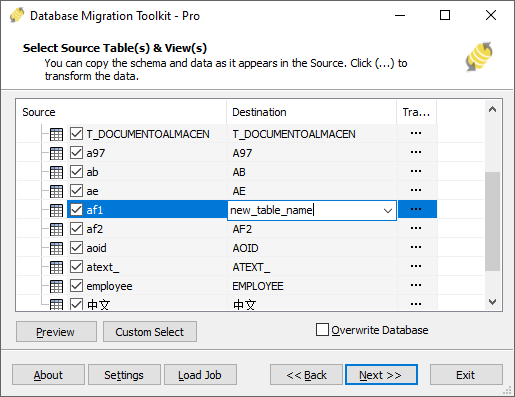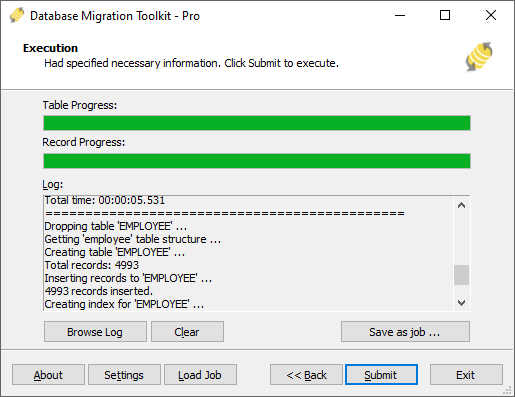Migrating data from SQL Azure to Excel(*.xls; *.xlsx)
This guide walks you through migrating data from SQL Azure to MS Excel in a few simple steps using ESF Database Migration Toolkit. Simplify complex migration tasks and save valuable time with our streamlined approach.
SQL Azure vs. MS Excel:
- Microsoft SQL Azure, also known as Azure SQL Database, is a fully managed relational database service provided by Microsoft. It offers scalable and high-performance SQL database capabilities in the cloud, with built-in high availability, automated backups, and robust security features. Designed to handle both small and large-scale applications, Azure SQL Database simplifies database management tasks, allowing developers to focus on building applications without worrying about underlying infrastructure. It supports various deployment options, including single databases, elastic pools, and managed instances, catering to diverse business needs.
- Microsoft Excel is a powerful spreadsheet software developed by Microsoft, widely used for organizing, analyzing, and visualizing data. It offers a wide range of features including calculation, graphing tools, pivot tables, and a macro programming language called Visual Basic for Applications (VBA). Excel enables users to create complex formulas, perform data analysis, and generate professional-looking charts and graphs. It is extensively utilized in various fields such as finance, accounting, engineering, and data analysis for its versatility and ease of use.
Prerequisite:
Software Required:
DMToolkit_x64.zip
(63.6 MiB)64-bit Windows application for ESF Database Migration Toolkit 12.2.08 (2025-07-11).
(md5: e93a0ef57622bfd8ee77d6aa6e38c13b)DMToolkit_win32.zip
(58.8 MiB)32-bit Windows application for ESF Database Migration Toolkit 12.2.08 (2025-07-11).
(md5: bd34cb7f73c88c6d0c7a44069ad756d6)System Supported:
- Windows 7 or higher.
- SQL Azure.
- MS Excel 97 or higher.
Step by Step Wizard:
-
Configure SQL Azure Connection
- Prerequisite:
- Enable "Allow access to Azure services" in Azure SQL server settings
- Add your client IP under Firewalls and virtual networks
- In the "Choose a Data Source" dialog:
- Select "SQL Azure"
- Enter connection details:
- Server name: e.g.,
esf.database.windows.net - Port:
1433(default) - Authentication: Enter credentials
- Server name: e.g.,
- Load database options:
- Click the Refresh Database button
- Select target database from list
- Load schema options:
- Click the Refresh Schema button
- Choose desired schema

Fig. 1: SQL Azure data source configuration - Prerequisite:
-
Microsoft Excel Destination Configuration
- In the "Choose a Destination" dialog:
- Select "Microsoft Excel(*.xls;*.xlsx)"
- File selection:
- Click the "..." button (Browse)
- Select your target Excel file (.XLS or .XLSX format)

Fig. 2: Microsoft Excel destination configuration - In the "Choose a Destination" dialog:
-
In "Select Source Table(s) & View(s)" Dialog
-
Select migration objects: Choose tables or views to include in the migration.

Fig. 3: Select tables and views -
Modify table structure: Click the ellipsis (...) button to access table options and schema adjustments.

Fig. 4: Do transform -
Configure field mapping: In the Field Mapping options:
- Customize destination fields (name, data type, default value, comments)
- Select data transfer method:
- Overwrite Table (replace existing data)
- Empty Data (truncate before insert)
- Append Data (add to existing data)
- Skip Table (exclude from transfer)
- Apply data filters before transfer
-
Select migration objects: Choose tables or views to include in the migration.
-
Execution Dialog
-
Start migration: Click "Submit" to initiate automated data transfer from SQL Azure to MS Excel.

Fig. 5: Execute migration - Monitor progress: Click "Browse Log" for real-time migration tracking, including issue resolution details.
-
Save configuration: Click "Save as job" to store settings for:
- Quick reloads of migration jobs
- Command-line execution (use:
dmtc.exe --helpfor parameter options)
-
Start migration: Click "Submit" to initiate automated data transfer from SQL Azure to MS Excel.
-
Finished!
After migration completes, the toolkit generates a comprehensive report for verifying migration accuracy. You can monitor progress as the automated process runs efficiently. For any questions or feedback, contact us – our team is ready to assist.